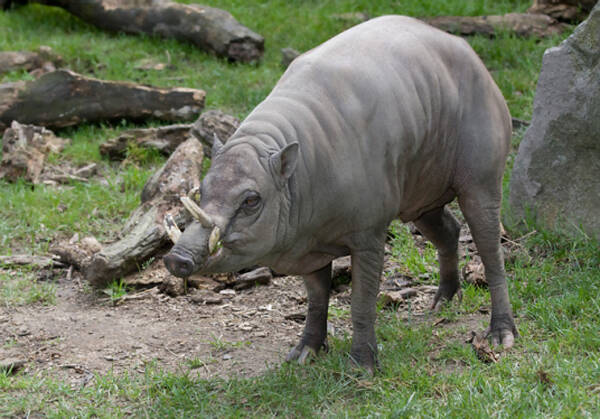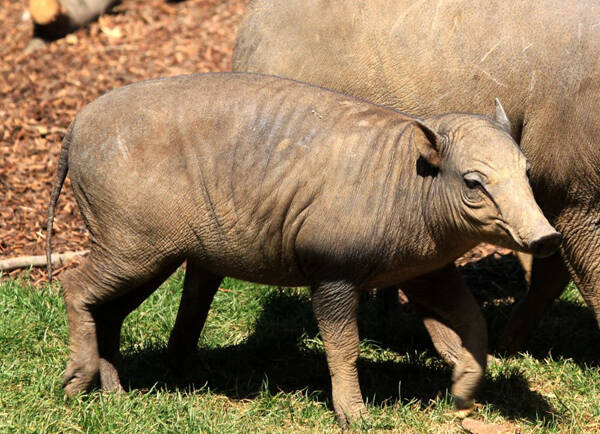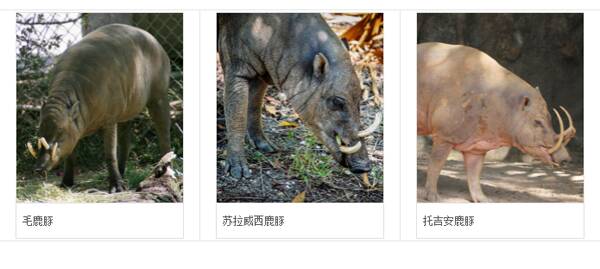Babyrousa babyrussa
IUCN
LCBasic Information
Scientific classification
- name:Babyrousa babyrussa
- Scientific Name:Babyrousa babyrussa,Hairy Babirusa、Babiroussa,Moluccan wild boar, Babirusa pig deer, Maluku babirusa
- Outline:Ungulata
- Family:Artiodactyla Suidae Babirusa
Vital signs
- length:1.2-1.4m
- Weight:43-100kg
- lifetime:About 24 years
Feature
It is the wild boar with the smallest skull shape.
Distribution and Habitat
Distributed in Indonesia, on two islands of the Sula Archipelago, Mangole and Taliabu, and Buru. The species originally distributed in Sulawesi has become extinct.
Lives in hilly areas far from human habitation. Prefers moist forests and thickets near the shores of rivers and lakes, inhabits rainforests in rivers and ponds, where aquatic plants are abundant, and avoids dense shrub vegetation. Restricted to highland forests and mountainous terrain, far from human habitation.
Appearance
The hairy babirusa is 1.2-1.4 meters long and weighs 43-100 kilograms. It is the wild boar with the smallest skull shape. Males are larger than females. It has a barrel-shaped body with a slightly pointed and relatively long nose. The skin is rough, often with large folds or wrinkles, and the limbs are thin and long. The most striking feature is that they have two pairs of tusks. These 4 tusks are bent backwards in front of the eyes. The lower tusks, like wild boars, protrude outside the lips and block the eyes; the upper tusks grow upward from the mouth, through the upper jaw and face, and the upper tusks do not enter the mouth, but grow upward, through the snout, and bend backwards to the forehead. The male tusks can be up to 30 cm long; these upper tusks are usually divergent or parallel to each other. Compared with other wild boar species, the tusks tend to be smaller and thinner, and the upper canines are closer to the end of the nose, with a larger gap between them. When viewed f
Details
Hairy Babirusa (scientific name: Babyrousa babyrussa) is also known as Hairy Babirusa and Babiroussa in foreign languages. There is no subspecies.

Hairy Babirusa is a diurnal animal that is active mainly in the morning. It spends about half of its time lying down, usually sleeping. They run fast and often swim in the sea to reach offshore islands. They build straw nests and wallow in the mud. Unlike other wild boars, male babirusa actively grind their teeth in trees to keep their lower tusks sharp. They make a "hissing" call when they are excited.
Babirusa do not destroy crops like other wild boars that inhabit islands. They are most common in the morning and evening. Like other wild boars, they soak and wallow in puddles and rivers. They have fast uphill runs and good swimming abilities. Although usually quiet, the main vocalization may be similar to the grunts of other pigs. The tusk wear pattern on the upper canines of males suggests that head-on fighting may play a role in aggressive encounters between individuals. Old reports have recorded that males would hook their tusks on branches or vines to help them stand on their hind legs to sleep, but it seems doubtful whether this actually happened.
Adult male babirusas are primarily solitary, while adult females are often found in small family groups, with most groups consisting of 5 or fewer animals, often including a few young and/or sub-adults. Like other wild boars, they are very vocal with low moans or grunts, but have a limited vocabulary. Like other wild boars, babirusas are not considered particularly dominant, although they will mark their home ranges in various ways. For example, adult males in captivity have been observed engaging in "ploughing." When placed into an empty, sand-filled pen, they will dig their snouts deep into the loose soil, kneel down and slide forward on their chests. There is a large amount of salivation during "ploughing," suggesting that this unique behavior has a scent-marking function.

Like most other wild pigs, the babirusa is an omnivore, with both wild and captive individuals consuming a wide variety of leaves, roots, fruits, and animal matter, including invertebrates and small vertebrates. In Sulawesi, they visit volcanic areas and lick salt, drink water, and ingest soil salts, and from an anatomical digestive perspective, the babirusa is most likely to ferment fruit using a non-ruminant fore stomach. Their jaws and teeth are reportedly strong enough to easily crack very hard nuts. However, due to the lack of a medullary bone in their snout, the babirusa does not exhibit the rooting behavior typical of other wild boars. They dig their snouts into soft sand as well as moist, muddy soil to find food. They mainly eat leaves, leaf litter and fungi, but also tubers and fruits.
The mating system of the babirusa has been described as a "mobile dominance hierarchy" among males in the same area. Males use their tusks to compete with other males for the right to mate with several females. The gestation period of female babirusa is 150-157 days, with 1-2 pups born per litter. The pups weigh between 380-1050 grams. The pups, which are usually born in the first few months of the year, mature more precociously than the pups of other wild boars, starting to eat solid food 3-10 days after birth and mating at 6-8 months. They reach sexual maturity at 1-2 years of age. In captivity, the babirusa can live up to 24 years.
Easily identifiable by its shape and fur, the babirusa has some noticeable hair, unlike the hairless appearance of the Sulawesi babirusa. Compared to the Togian babirusa, the babirusa is smaller, has denser hair, and is not pale underside.

Due to its restricted distribution (occurrence is less than 20,000 square kilometers), the babirusa is classified as vulnerable, limited to two islands, the Sula and Buru, with the remainder of Minori, a third island, almost completely wiped out. Most of the largest island in the Sula, Taliabu, remains forested, but lowland forests have been extensively logged. Forests north of Buru have been degraded and cleared in coastal lowlands.
The wild population of the babirusa is estimated at approximately 4,000 individuals, spread across several islands. In addition to humans, they are also preyed upon by wild and domestic dogs. Large-scale commercial logging and shifting cultivation pose a significant threat to the species. The species has been declining in numbers, primarily due to habitat loss from logging and land conversion, and to some extent, in some areas, as local non-Muslim village communities continue to hunt wild boars due to disease. Habitat quality and the number of mature individuals are expected to continue to decline to some extent.
Despite long-standing legal protection, excessive hunting and habitat loss have led to a significant decline in the babirusa population. In 1931, the babirusa was given full protection under Indonesian law. The remaining Buru rainforest is divided into two protected areas, Gunung Kelpat Muda (1,380 km²) and Waeapo (50 km²). There is also a Pulau Taliabu (700 km²) protected area on Taliabu Island. Gunung Kelpat Muda is located in the central-western part of the island. It has the added advantage of continuing to be an animal sanctuary according to local customs. It has always been rare in zoos, but seems to breed easily in captivity. The largest breeding organization is at a zoo in Surabaya, Indonesia. Stuttgart Zoo coordinates a European conservation breeding program for wild boars.
Listed in the IUCN Red List of Threatened Species in 2008 ver 3.1 - Vulnerable (VU).
Listed in the CITES Appendix I of the Washington Convention as a protected animal.
Protect wild animals and eliminate game.
Maintaining ecological balance is everyone's responsibility!








